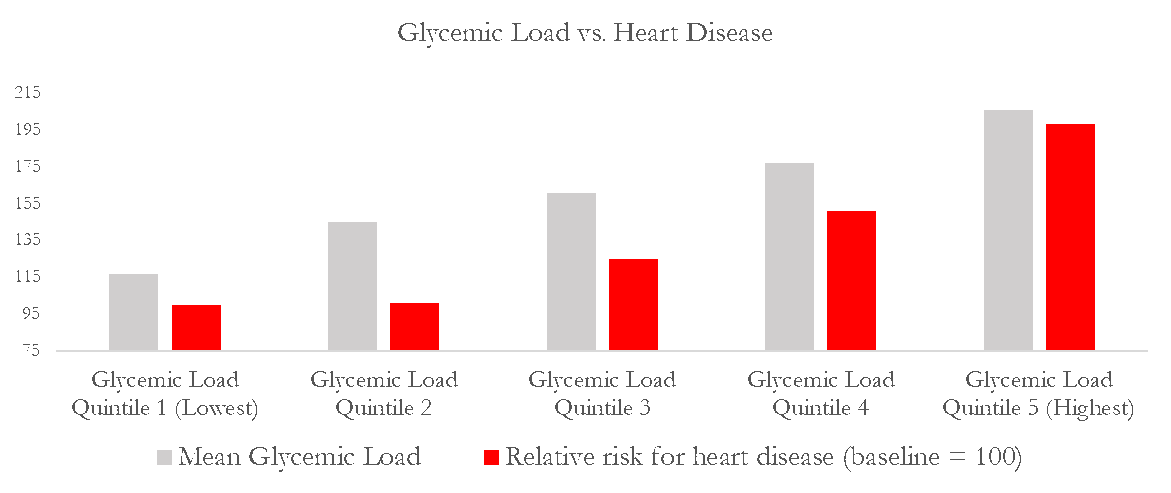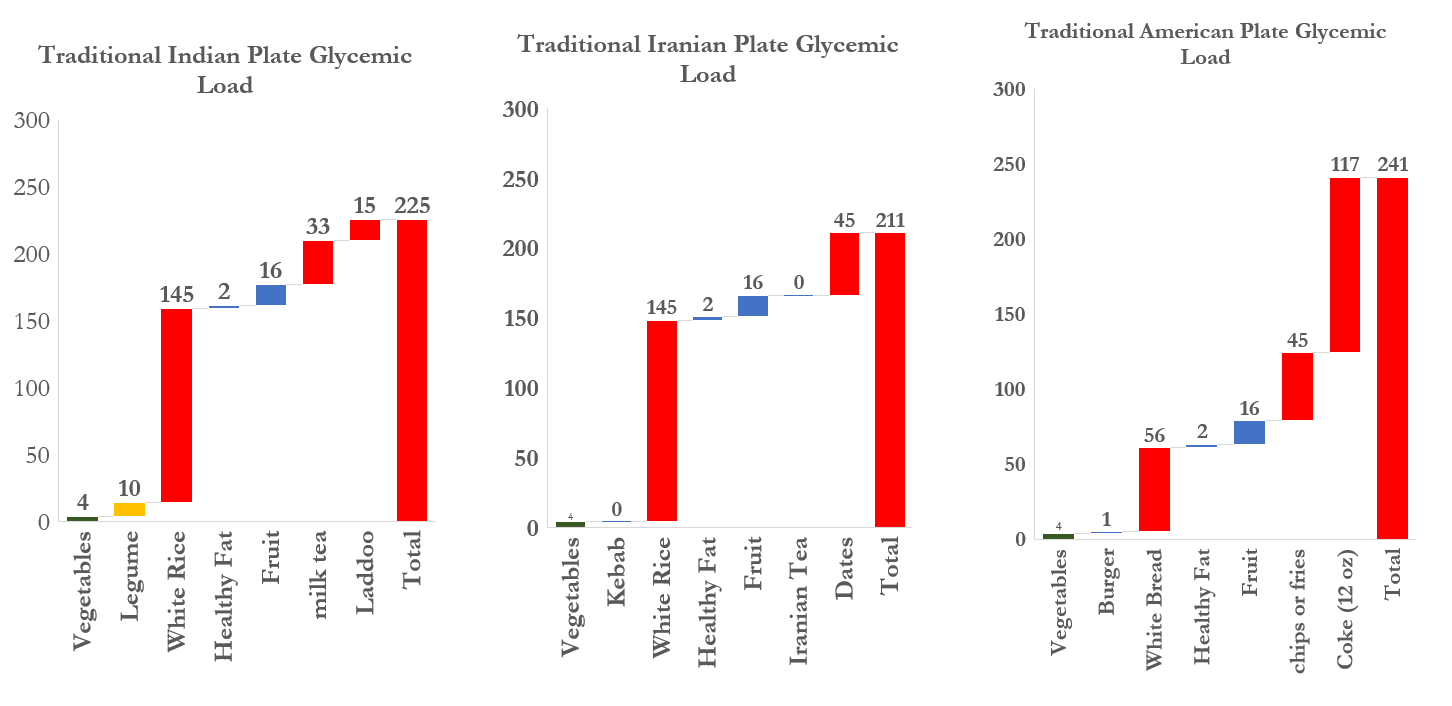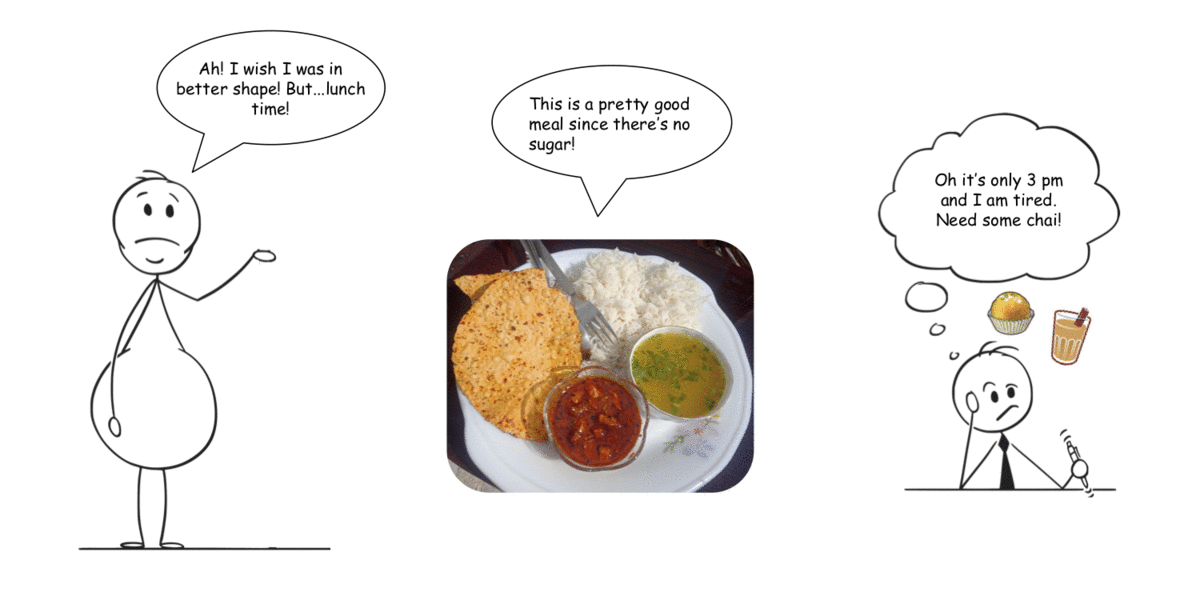Here with a loaf of bread, beneath the bough...the 1 in the Sabzbag 0-1-2-3: |
|
|
|
Do too much grains and sugar have similar bad effects on the body?
The Sabzbag nutrition framework most simply stated as 0 servings of junk- 1 serving of grain - 2 servings of legumes - 3 servings of vegetables, recommends a lower consumption of grains. This lower consumption of grain is based on widespread agreement - 70% of the 50 best-selling books on nutrition as well as many research papers such as the EAT-Lancet meta-study of 350+ academic articles are united on this. What is surprising is that the reasoning behind eating a lower quantity of grains - to lower the glycemic load is similar to the 0 consumption of sugar recommendation that we covered in the previous issue. Sugar and refined carbohydrates both have a high glycemic load meaning consuming them rapidly raises the blood glucose and hence the risk of type 2 diabetes. In fact, eating lots of veggies and lentils, in addition to low grain and no sugar - which makes our meals low glycemic load - will result in greater satiation and fewer food cravings.
|
 |
|
|
|
Figure 1 (from American Journal of Clinical Nutrition, Liu et al., June 2000) shows that higher glycemic load across 75,521 women followed for 10 years is related to the incidence of heart disease. The lowest risk is 100 and a higher score means higher risk and the average glycemic loads of quintiles from table 1. The risk factors are adjusted for all fats. |
What exactly is glycemic load and what is its relationship with the glycemic index?
Glycemic load is a product of two components: the glycemic index and the grams of carbohydrates divided by 100. Glycemic load = Glycemic Index * grams of carbohydrates/100
The Glycemic index is simply a number between 0 to 100 representing relative rise in blood glucose level two hours after consuming that food, with pure glucose being 100. In other words the formula above tells us:
Impact on body = " GLUCOSENESS" (or how "sugar-like" the carbohydrate is) * AMOUNT of the carbohydrate available.
Examples: Fruits like raw watermelon that might contain fructose that is similar to glucose with a glycemic index of 72 (high) may still have a low glycemic load since the amount of sugar in a 120 g of water melon is only 6 g - most of the rest - 110 g is water! Hence the glycemic load of the 120 g watermelon is only about 4.3. But white rice with a glycemic index of 73 and 66 grams of carbohydrates per 300 g typical serving in a traditional Indian meal plate, would have a glycemic load of 48 which is quite high.
What are the two ways of lowering the glycemic load?
From the formula, we can see that there are two ways of lowering the overall glycemic load: either eat carbohydrates with lower glycemic index or lower the amount of carbohydrates consumed. Thus, eating whole grains like brown rice or quinoa instead of white rice would lower the glycemic index and eating less grain would lower the total amount of carbohydrates.
|
|
|
|
|
Figure 2 (b) shows the low (< 100) and balanced glycemic load the Sabzbag 0 junk - 1 grain - 2 legumes- 3 veggies framework based plate achieves. |
|
|
The zero to hero transformation:lowering the glycemic load to 100 or below
The recommended glycemic load per day is less than or equal to 100. We can see from figure 1 that as the daily glycemic load increased from about 117 for quintile 1 of the 75,521 women to a highest of about 206 for quintile 5, the rate of heart disease doubled after adjusting for their fat intake. |
|
|
 |
Figure 3 provides details of the high glycemic load breakdowns. In the Indian and Iranian plates, grains are responsible for most of the high glycemic load, whereas in the American diet, sugar via ultra-processed food is more responsible for the high glycemic load. |
|
|
The great news is that a small change to our plate - simply changing the ratios to 0 junk - 1 grain - 2 legumes - 3 vegetables will get us big results: we can personally verify the academic finding that it is possible to eat more food and get leaner and healthier! Basically, the glycemic load declines by working on both fronts - we are eliminating sugar and refined grains and hence lowering the glycemic index as well as reducing the quantity of grain eaten. This double whammy is truly a zero to hero transformation - something Omar Khayyam the Persian genius whose timeless verse we mangled, would be delighted about. Figure 4 shows how we can change the typical Indian, Iranian and American plates with high glycemic loads of 200+ to a glycemic load of < 100 which is better than even the healthiest quintile in the study above.
|
|
|
 |
Figure 4 Shows how simple and easy changes to our plate can produce big results |
|
|
|
FAQ
What is a refined grain and why does it taste so good?
Refined grain” is the term used to refer to grains that are not whole, because they are missing one or more of their three key parts (bran, germ, or endosperm). These refined grains are missing many essential nutrients such as phytochemicals, minerals as well as fiber that can help prevent diabetes and other diseases.
Consuming refined grains and sugar "lights up" the reward centers in our brain and causes glucose levels in the blood to spike and these spikes cause people to crave more food for as long as the next four hours. These effects are so strong that they can be considered addictive by some.
Are refined grain really that bad for us?
Yes. The Eat-Lancet meta study is quite unambiguous on the topic:
"refined grains are a major source of high-glycaemic carbohydrates, which have adverse metabolic effects and are associated with increased risk of metabolic abnormalities, weight gain, and cardiovascular disease."
" high carbohydrate intake increases blood triglyceride concentration, reduces HDL chol esterol concentration, and increases blood pressure, especially in individuals with insulin resistance."
Which food habit is better? LESS grain (more veggies) or WHOLE grains like brown vs. white rice?
Eating whole grains is definitely better for us, but eating less grain (and more veggies) is way more powerful. A study found that eating brown rice rather than white rice reduced the inflammation and can significantly help with weight reduction and waist and hip circumference in women by 1.2 Kg over 6 week interventions. However, another study found that the effects of eating more plant foods in just 21 days was to lose 7.8 kg! and improve other markers like blood pressure and cholesterol.
We can see from figure 2, that the "healthy traditional Indian plate" that cuts out the sugar and substitutes brown rice for white rice lowers the glycemic load to 141 from 225, but simply switching the ratios to 0-1-2-3 and eating a lot more vegetable dramatically lowers the glycemic load to 84. The other benefit of eating the 0-1-2-3 plate in contrast to the healthy plate is that it demands less discipline in terms of portion size - vegetables have very low glycemic load - and one can practically eat as much as one wants!
What about gluten?
This is a popular topic! As nutrition source at Harvard says - "Gluten is a protein naturally found in some grains including wheat, barley, and rye. It acts like a binder, holding food together and adding a 'stretchy' quality." It seems some people truly have celiac disease but other than that, it does not seem to matter that much: In a 2017 study of over 100,000 participants without celiac disease, researchers found no association between long-term dietary gluten consumption and heart disease risk. |
|
|
|
|
|
The Sabzbag 0 -1 - 2 -3 Home project:
How do real people deal with social pressure and make it easier to be healthy at home?
|
Following the 0-1-2-3 nutrition framework in real life requires many small changes that add up to a wonderful cumulative effect. But any change is risky and requires effort. In this edition, our special guest, ChandraKala Jain shares her journey of using fun experiments to build the infrastructure for a healthy home in the form of Sabzbag Home Project. She discusses her challenges of lowering junk in face of social pressure and the ways to overcome daily temptations to make it easy to follow a healthier lifestyle at home. |
 |
|
|
|
|
|
|
|
